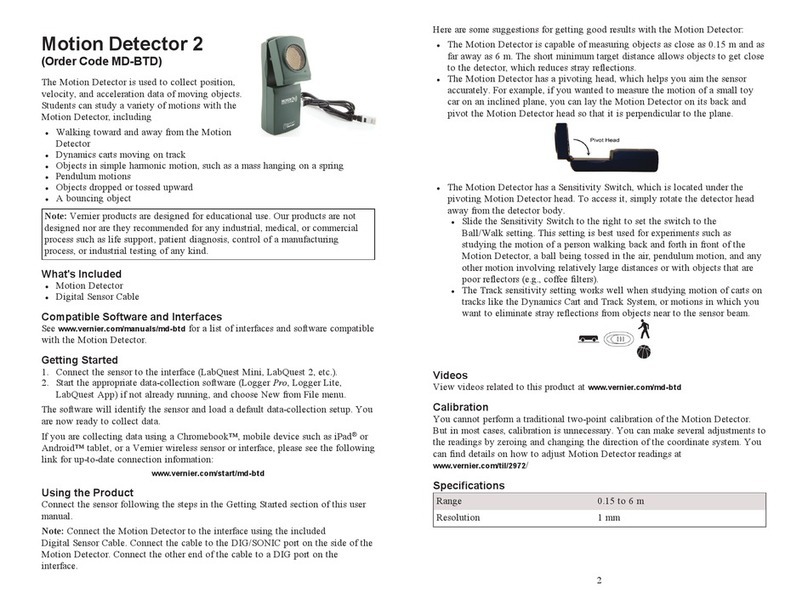
3
power button for more than three seconds). Disconnect the sensor and charging
cable, and remove the battery. Allow the device to dry thoroughly before
attempting to use the device again. Do not attempt to dry using an external heat
source. Note: Damage due to liquid is not covered under warranty.
Troubleshooting
For troubleshooting and FAQs, see www.vernier.com/til/17351
Repair Information
If you have watched the related product video(s), followed the troubleshooting
steps, and are still having trouble with your Go Direct PAR, contact Vernier
specialists will work with you to determine if the unit needs to be sent in for
repair. At that time, a Return Merchandise Authorization (RMA) number will be
issued and instructions will be communicated on how to return the unit for repair.
Related Products
Item Order Code
Go Direct Optical Dissolved Oxygen GDX-ODO
Go Direct CO2Carbon Dioxide Gas GDX-CO2
Go Direct Tris-Compatible Flat pH GDX-FPH
Go Direct Conductivity GDX-CON
Water Quality Bottles (8) WQ-BTA
Warranty
Warranty information for this product can be found on the Support tab at
www.vernier.com/gdx-par
General warranty information can be found at www.vernier.com/warranty
Disposal
When disposing of this electronic product, do not treat it as household waste. Its
disposal is subject to regulations that vary by country and region. This item should
be given to an applicable collection point for the recycling of electrical and
electronic equipment. By ensuring that this product is disposed of correctly, you
help prevent potential negative consequences on human health or on the
environment. The recycling of materials will help to conserve natural resources.
For more detailed information about recycling this product, contact your local city
office or your disposal service.
Battery recycling information is available at www.call2recycle.org
Do not puncture or expose the battery to excessive heat or flame.
The symbol, shown here, indicates that this product must not be disposed of in
a standard waste container.
Materials Anodized aluminum with case acrylic lens
Operating environment –10 to 60°C
0–100% relative humidity
Sensor head and cable can be
submerged in water to sensor box
Care and Maintenance
Cleaning the Go Direct PAR Sensor
Debris on the Go Direct PAR Sensor lens will partially block the optical path and
will lead to low readings. Dust and other organic deposits are best removed using
water or window cleaner. Never use an abrasive cleaner on the lens. Salt deposits
can also accumulate on the sensor lens over time due to evaporation from sea
spray, sprinkler irrigation water, or wave splash. Salt deposits should be dissolved
with vinegar and then removed using soft cloth or cotton swabs.
Go Direct PARSensor Head Connector
The head of the Go Direct PAR Sensor is attached to the main cable using a
P68-rated stainless-steel marine grade (M8)connector. This connector is located
25cm from the sensor head. The connector is used for removing the sensor head
during routine calibration, replacement, or maintenance by the manufacturer.
Please do not remove the sensor head from the main cable. For the connector to be
waterproof, confirm that the cables are firmly connected and the threaded
connectors are finger tight.
Battery Information
The Go Direct PARSensor contains a small lithium-ion battery in the sensor box.
The system is designed to consume very little power and not put heavy demands
on the battery. Although the battery is warranted for one year, the expected battery
life should be several years. Replacement batteries are available from Vernier
(order code: GDX-BAT-300).
Storage and Maintenance
To store the Go Direct PARSensor for extended periods of time, put the device in
sleep mode by holding the button down for at least three seconds. The red LED
will stop flashing to show that the unit is in sleep mode. Over several months, the
battery will discharge but will not be damaged. After such storage, charge the
device for a few hours, and the unit will be ready to go.
Exposing the battery to temperatures over 35°C (95°F) will reduce its lifespan. If
possible, store the device in an area that is not exposed to temperature extremes.
Water Resistance
The sensor head and main cable for the Go Direct PAR are waterproof and can be
fully submerged up to the box containing the electronics (approximately 5 meters).
The sensor box is not waterproof and should never be immersed in water. If any
liquid gets into the device, immediately power the unit down (press and hold the























